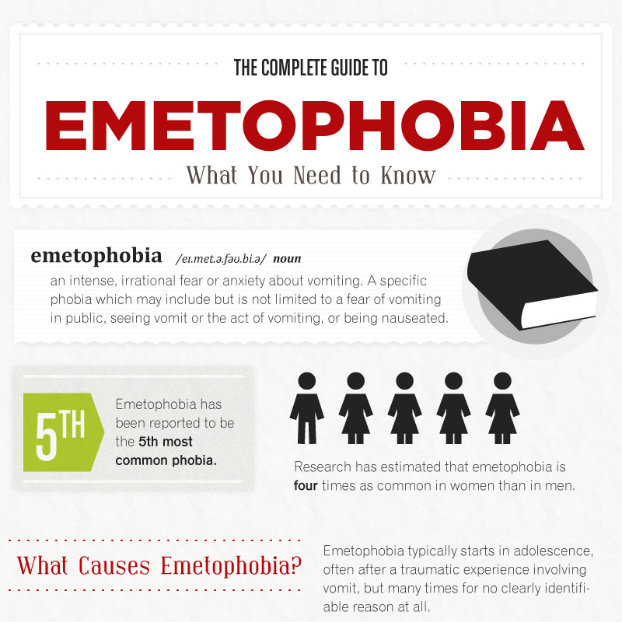
What Is Emetophobia?
Emetophobia is a very strong, persistent fear of vomiting or of seeing someone else vomit. People who have emetophobia may also be afraid of feeling nauseated.
How Does Someone Develop Emetophobia?
A desire to avoid being ill or to avoid being around others who are ill is a natural human instinct. Emetophobia takes this instinct and magnifies it until the fear becomes exaggerated and impractical.
Usually emetophobia develops after a person has had an experience with being violently ill. Other disturbing situations involving being sick or seeing someone else get sick can also lead to the development of emetophobia.
Children are especially likely to develop emetophobia after a traumatic experience with illness.
How Does Emetophobia Affect Daily Life?
Some people who have emetophobia strive to avoid any situation that has the potential to cause illness. This can lead to avoidance of a number of activities and situations. A person with severe emetophobia may avoid crowded places, refrain from drinking alcohol or attending parties, or even decide not to have children (basically because kids are often sick).
For children who develop emetophobia, the resulting behaviors can be extreme. Some kids who have emetophobia will refuse to eat a variety of foods for fear of being ill. When this happens, it can harm their nutrition and interfere with their growth and development.
Total food refusal can also occur in a child after the onset of emetophobia. This, of course, is a very drastic result of the phobia which is not especially common. Immediate intervention by a licensed mental health worker is usually needed for children who refuse to eat for fear of being sick.
A trained therapist or psychiatrist can help a child to eliminate the extreme fear and start eating a balanced diet again.
How Is Emetophobia Treated?
Typically, emetophobia and other phobias are treated with systematic desensitization. The client is slowly taught to eliminate anxiety felt around the object of fear. During this process, the affected person learns to react to the presence of the feared object with calmness.
Here’s an example of how systematic desensitization works using a common fear known as arachnophobia (the fear of arachnids such as spiders). For a person who went to therapy for this issue, the counselor would first teach him or her to stay calm while looking at a picture of a spider. The person might be asked to look at the photo for a brief period of time, and gradually he or she would learn to look at it without feeling any fear or discomfort. At each step, the client would practice using relaxation techniques such as deep, measured breathing. The therapist must help the phobic person to stay in control and face the feared object without anxiety and with an understanding that no harm is forthcoming.
The process of systematic desensitization can be slow and somewhat difficult, but it is important not to rush so the person is less likely to experience a return of the phobic symptoms after therapy has ended.
A Case Study on Emetophobia Treatment
In a case study of an eleven-year-old child with emetophobia (“Competence Imagery: A Case Study Treating Emetophobia”), two researchers observe the efficacy of treating the girl using a less common approach.
When the child was treated with systematic desensitization, she did not see an improvement in her symptoms. The psychologists proposed using Competence Imagery, instead. This entailed “systematically pairing anxiety-provoking [situations]” (the researchers used “video scenes of someone vomiting”) with positive mental imagery. The psychologists asked the girl to imagine doing something she was successful at while watching the fear-provoking videos.
This approach proved to be effective in treating the girl’s emetophobia. Over a period of weeks, she reported feeling less anxiety about being sick. Two years after her treatment, she remained healthy and free from emetophobia.
Large Photo Credit: Summer Gloaming via Compfight cc





